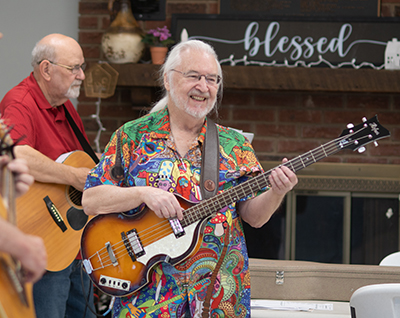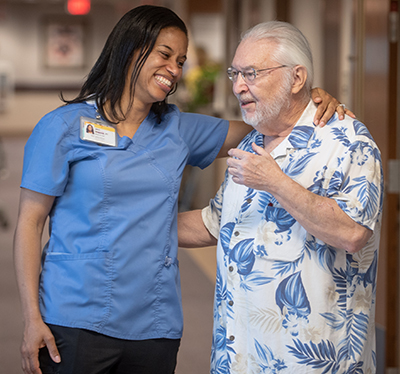 In August 2012, retired voiceover artist and radio announcer Bill Price’s stroke symptoms appeared suddenly and severely. The then-61-year-old had just returned home from work. As Bill made his way to the bathroom, his left leg gave out and he collapsed to the floor. In the process, he shattered his cordless phone - and his ability to call for help.
In August 2012, retired voiceover artist and radio announcer Bill Price’s stroke symptoms appeared suddenly and severely. The then-61-year-old had just returned home from work. As Bill made his way to the bathroom, his left leg gave out and he collapsed to the floor. In the process, he shattered his cordless phone - and his ability to call for help.
With no dial tone on his cordless phone, Bill dragged himself to the kitchen, not knowing he was suffering from a stroke. He called his then-girlfriend on his corded landline phone. His girlfriend, who was traveling at the time, called his landlord, who then called 911 and came to his home to unlock his door to let emergency medical services (EMS) inside.
EMS, Bill’s son and his landlord arrived around the same time. EMTs confirmed Bill’s blood pressure was “outrageously” high and immediately transported him to Atrium Health Wake Forest Baptist High Point Medical Center, where he was diagnosed with a hemorrhagic stroke caused by a hypertensive crisis (extremely high blood pressure). A hemorrhagic stroke is caused by bleeding in the brain. Hemorrhagic strokes account for 13% of strokes.
His emergency medical team gave him medication to stop the bleeding and got him stabilized.
Recovering in stroke rehabilitation
Bill spent a week in the hospital and was then transferred to High Point Medical Center’s stroke rehabilitation facility adjacent to the hospital. Inpatient stroke rehabilitation is for people who no longer need intensive medical care in the hospital, but still require close monitoring and a transition of care focused on recovery.
“Stroke rehabilitation is crucial after a stroke,” says Dr. Amy Guzik, a neurologist and director of the Comprehensive Stroke Center at Atrium Health Wake Forest Baptist. “The more therapy you get and the earlier you get it, the more recovery you can expect and the better you’ll do long-term.”
During rehabilitation, patients work with physical therapists, occupational therapists and speech therapists. Treatment can not only improve strength and reduce disability, but it can get people back to the activities they need and want to do when they leave the hospital. In Bill’s case, it was playing his guitar, bass guitar and drums.
“Most people spend a week to a month in inpatient stroke rehabilitation,” says Guzik. “When the rehabilitation team feels that it’s safe for a patient to return home, the patient can transition to outpatient therapy in the community to continue their recovery.”
Atrium Health Wake Forest Baptist has a stroke rehabilitation center attached to the hospital. High Point Medical Center also has a stroke rehabilitation facility, allowing people in and near High Point to get stroke recovery care closer to home.
Bill’s rehabilitation treatment plan included occupational therapy to help him regain skills like cooking and dressing. He also went through physical therapy to regain his ability to walk. Bill even had his son bring his guitar to stroke rehabilitation, where he was diligent about regaining his musical abilities.
Once the rehab team determined it was safe for Bill to go home, he went to stay with his girlfriend, who had a one-level home.
“There’s a lot to be said for the facility at High Point Medical Center and the care they give,” says Bill. “I told the therapists to push me hard because I wanted to get back to normal as fast as I could. They helped me get back on my feet relatively quickly.”
Two months later, Bill played the drums and guitar again in his church’s praise band.
“Having a stroke woke me up,” he says. “I asked myself, ‘How do I not wind up back in the hospital?’ I’ve been taking my blood pressure medications religiously since the stroke.”
Thriving after stroke recovery
Nearly 11 years after his stroke, Bill is living a full, fun life. A gifted guitarist, drummer and bass player, he performs with friends at open-mic nights, retirement communities and churches.
“It’s rewarding to take music to people and hope it makes their day better,” he says.
He now returns to the stroke rehabilitation facility to play for patients and give them hope.
“I told patients, ‘Y’all pay attention to your physical therapists,’” he says. “When I first got here, I couldn’t stand up. Now I’m singing and emceeing this event. With your OK, the therapists and doctors will get you back as close to normal as you can get.”
The importance of a stroke support group
Even with his relatively quick and full recovery, Bill found immense value in attending High Point Medical Center’s stroke support group.
“As soon as I found out about the support group, I started attending,” he says. “We’ve been meeting on Zoom for the past few years. We support and encourage each other and have an annual Christmas event where I play music for the group.”
“Going home after a stroke is a big transition, so it’s good to have support as you figure out how to get back to your life,” says Guzik. “We talk about physical changes after a stroke, but there are emotional challenges as well. Having a support group of people who have gone through similar experiences is helpful for navigating life after a stroke.”
Bill’s encouragement to other stroke survivors
 Reflecting on his stroke and recovery nearly 11 years ago, Bill encourages other stroke survivors to challenge themselves in physical and occupational therapy and to go at their own pace.
Reflecting on his stroke and recovery nearly 11 years ago, Bill encourages other stroke survivors to challenge themselves in physical and occupational therapy and to go at their own pace.
“I responded extremely well to therapy,” he says. “If my friends hadn’t visited me in the hospital, they would never have known I’d had a stroke. I attribute my recovery to God’s healing and High Point Medical Center’s physical therapists. I brag on that place to anyone who wants to hear about it.”
Know stroke’s warning signs
Bill also encourages people to learn about stroke symptoms.
“The hemorrhage would have killed me in a short period of time if I hadn’t called for help,” he says.
Guzik explains that there are two main types of strokes:
- Ischemic, which is caused by a blood clot in the brain that limits blood flow to brain tissue
- Hemorrhagic, which is caused by bleeding in the brain (the type of stroke Bill experienced)
Symptoms will vary depending on where in the brain the stroke occurs. Use the acronym “BE FAST” to quickly remember stroke symptoms:
- B: Balance loss
- E: Eyesight changes
- F: Facial drooping
- A: Arm weakness
- S: Speech difficulty
- T: Terrible headache and time to call 911
“There are things we can do to treat a stroke, but we have limited time,” says Guzik. “We often say, ‘Time is brain.’ Every minute during a stroke, 2 million neurons are at risk of damage if treatment is delayed.”
Getting care as quickly as possible potentially reverses brain damage, limits tissue damage and lowers the likelihood of long-term symptoms after a stroke.
How common are strokes?
“In the United States, someone has a stroke every 40 seconds—that’s nearly 800,000 strokes every year,” says Guzik. “Stroke is a leading cause of death and long-term disability.”
North Carolina is part of the “Stroke Belt,” which means the state has higher incidences of stroke, higher mortality rates from stroke and more complications from stroke.
“A lot of it is related to higher rates of risk factors like high blood pressure, high cholesterol, smoking and diabetes,” says Guzik. “All of these have a cumulative effect on stroke risk.”
Stroke risk factors
The main stroke risk factors include:
- Smoking
- Diabetes
- High blood pressure
- High cholesterol
- Age (risk increases with age)
- Taking birth control pills
- Preeclampsia (high blood pressure during pregnancy)
- Being Hispanic, African American, American Indian or an Alaska Native
- Having a parent or other relative who had a stroke, particularly at a young age
Other risk factors include:
- Being overweight or obese, particularly having extra weight in your midsection
- Lack of physical activity
- Drinking alcohol
- Using illegal drugs
- Eating unhealthy foods
- High stress levels
- Anxiety
- Depression
- Getting too much sleep (9-plus hours a night)
- Having sickle cell disease, kidney disease, sleep apnea, migraine headaches or sleep disorders
“The risk of stroke increases with age, but strokes can happen at any age,” says Guzik. “We’re seeing more strokes in young people in their 20s, 30s and 40s because of risk factors like uncontrolled high blood pressure and smoking. It’s important to manage your stroke risk factors at every age.”
Stroke treatment options
There are medical and surgical options for both clotted and bleeding strokes, says Guzik. For bleeding strokes, surgical options stop the bleeding or brain damage. For clotting strokes, medical providers can use clot-busting medications or catheter-based surgical procedures to open up blocked blood vessels.
“Make sure you talk to your primary care provider about your stroke risk factors,” says Guzik. “And if you see stroke symptoms in yourself or someone else, call 911 right away.”
Learn more about stroke treatment at Atrium Health Wake Forest Baptist’s Comprehensive Stroke Center.
